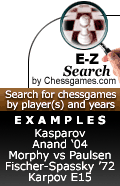By: Resty Par
I have read a lot of tips about self-improvement in chess, most of which I found useful and effective. However, I noticed that one PRACTICAL tip was missing in what I’ve read. I consider the tip that I thought of as the necessary concrete foundation for all the “academic” tips that I have come across with. Some may consider my idea as no longer new, nonsensical and immaterial, but this may set a firm foundation for somebody who really wants to improve in this mind sport.
The tip that I want to share is this: HAVE YOUR OWN CHESS SET.
Sounds funny, right? But don’t ignore this very basic tip. From this simple idea can ensue grand things for self-improvement in chess.
In the first place, I may not be in the position to talk about self-improvement in chess since I don’t have any titles in chess. I am not even a national master; neither have I won any mini-tournament. I am even reluctant to say that I have reached the so-called intermediate level. This article may raise some eyebrows of some readers who know my playing strength. But let me clarify that I am speaking based only on my own experience. This is how I feel that I was able to improve – no matter how slight in the eyes of others may be – my skills in this mind sport. This tip that I prescribe is effective for a beginner player who wants to graduate to the intermediate level. I am not sure, though, if it also applies to the advanced or master level.
The most known tip in self-improvement in chess is to study tactics. As they say, chess is 90% tactics. Let’s say that that’s true. But studying tactics is arguably best done with the use of a chess board. Based on my own experience, learning the knight fork is best appreciated when one holds a knight and makes it jump over some pieces and pawns into the forking square.
Of course, reading printed materials, watching computer chess lessons, or solving tactical exercises online are also beneficial. All I can say is that one can maximize the potential of these resources with the use of a chess board. As I noticed in my own self-improvement program, printed materials and computer resources are two-dimensional (2-D) tools that, in one way or another, program my mind on how to see things. I observed that I am having a hard time adjusting my two-dimensional-trained-mind to a three-dimensional (3-D) set-up – that is, a game played over-the-board (OTB). (NOTE: I will extensively discuss this topic about 2-D vs 3-D in the future).
Aside from studying tactics, a lot of books recommend studying opening, middlegame and endgame principles, positional concepts, analyzing own games, analyzing games of the masters, solving puzzles, and so on. These are all good. But to maximize the potential of all these tips, they must be done with the use of a chessboard. The concepts and ideas contained in those books and CDs are best appreciated if personally LIVED by the players. The pieces must be touched and moved by the players. The concepts must not only exist in the mind but rather be LIVED through actual practice, particularly by beginners.
Now I realized why some books prescribe to solve the chess problems contained in them using a chessboard. I also observed that even the grand chess events, especially chess training, in the so-called powerhouse nations in chess, such as Russia, employ chessboards side-by-side big screens in studying chess lessons.
The chessboard is the real battle arena for chess – not the books, not the computers (unless of course one intends to participate exclusively in an online tournament or blindfold chess). I therefore conclude that before anybody intends to go further steps in chess, he or she should do the most basic thing – that is, he or she must have her own chess set first.
Monday, July 7, 2008
The most basic tip for self-improvement in chess
Posted by
RUSTICBULL
at
9:41 PM
![]()
Labels: chess tips, malibay chess club
Subscribe to:
Post Comments (Atom)



0 Comments:
Post a Comment